How to arrange a pipe box in the toilet: an overview of the best ways to mask the pipeline
Are you going to make repairs in the toilet and don’t know what to do with water pipes? Agree, a masked pipeline looks much more aesthetic.
For this purpose, various tricks and materials are used. Often, specialists from a construction organization are invited to work. Especially when you need to build a pipe box in the toilet from drywall. If the budget is limited, and the pipes do not fit into the interior at all, then you can fix it yourself by choosing a simpler option.
This article will discuss methods for masking a pipeline. We will talk about what tools and materials for this purpose are required. The material is accompanied by thematic photographs and videos that clearly demonstrate how you can mask the piping in the toilet with your own hands.
The content of the article:
The easiest way is decor
When the budget does not provide for repair costs, and the pipes in the toilet are annoying, you can do it with minimal expenses. It is about decorating the visible parts of the pipeline.
This method can be a real salvation when the head of the family instead of repair chooses other ways of spending leisure time - for example, fishing or basketball with friends. Moreover, both a woman and a man can cope with decoration. The main thing is to have inspiration.

Depending on preferences and moods, the pipeline can be disguised as anything - turn into a tree, into an animal or decorate it with beautiful decorative elements.
The main types of decoration:
- stick a film with a suitable pattern over the pipes;
- paint with waterproof paint the color of the walls in the toilet room;
- depict a unique pattern or reproduce a birch trunk, oak bark or other material with paints;
- use decorative stones, beads, chains, twine and other elements used for needlework.
The easiest and most convenient option is to paint the pipes with paint that harmoniously matches the color of the walls. Or stick a film with a pattern.
It is important here that the material can withstand a humid environment and high temperature if hot water enters the apartment through one of the pipes.

The decorating method is also great for masking pipes in the kitchen or in the bathroom. In addition to the decor for pipes in these rooms, you can use other methods of sheltering communications.
We recommend that you also familiarize yourself with the best options. masking gas pipesused by inventive hosts.
The second way - buying a finished box
Another option is to use a duct box. This may be the construction of a makeshift design or the purchase of a finished factory product. More simple is the second way.
The shape and size of the purchased boxes allows you to choose exactly the option that successfully disguises the external parts of the pipeline not only in the toilet, but also will hide the heating pipes in other rooms.
A significant drawback is that ready-made boxes cannot be used in bathrooms with a complex geometry of communication systems. This is when there are a lot of pipes, and they are randomly located throughout the room.
As for the material and color of the finished structure, there is a place where the buyer’s fantasies can take a walk - you can pick up almost any room design.
When the desired color is missing in the palette of the material you like, this can be fixed with moisture-resistant paint and a brush.
You can mount an advanced design only after the paint has completely dried. The exact time should be looked at the bank - the manufacturer must indicate this information on the label of its products.
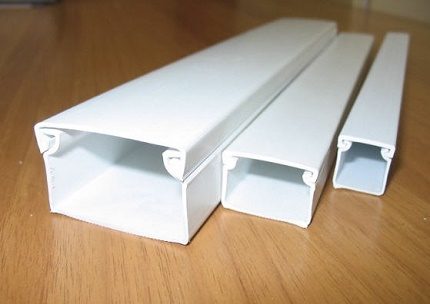
The installation process is extremely simple - you need to measure the desired length with a tape measure and, putting a mark with a pencil, carefully cut off the excess part of the structure.
Then attach the box to the wall with fasteners or liquid nails - it all depends on the type of material from which the structure is made and the manufacturer's recommendations for its installation.
The third way - assembling the homemade box
Often the option with decorating pipes is simply not suitable - there are too many pipes and they are not located in the most convenient way. Here another method of masking will come to the rescue - arrangement of the box, inside which all the pipes will be located.
Stage # 1 - determine the design of the box
The option of arranging a box for masking all pipes passing through the toilet room is the most popular among users.
This is not only an aesthetic, but also a practical solution - once you install the design, you can forget about the pipes, at least until the next major overhaul.
First, let's take a closer look at the most popular types of box construction - with a solid wall and an opening.
Option # 1 - solid wall box
Boxes with a solid wall consist of a frame, walls and, if necessary, facing material. Also, they must be equipped with a hatch for conducting an audit - inspection of the external condition of the pipeline and shutoff with a valve to supply water to the house / apartment.
Inside this design, all the pipes are hidden, and also, there can be hidden a flush tank of a hanging toilet and a bidet, a boiler and other unsightly communication elements.
Boxes come in a variety of shapes and sizes. Often a full-height box is called a false wall. This solution is used for vertically passing pipeline.
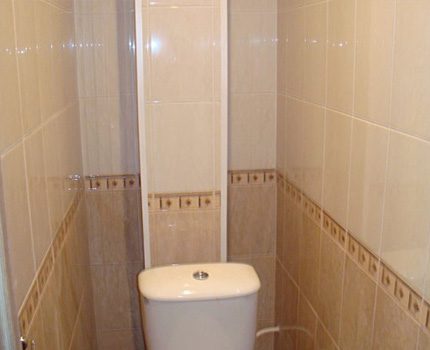
Plastic panels are especially loved - they are easy to install and remove if necessary. And the price of this material is more than affordable.
Nevertheless, even when making a plastic box, a hole should be provided that will easily open in the place where the valve stands to shut off the water supply.
If the false wall is made of drywall and tiled on top, then the presence of a revision window is a necessity - in case of any problems with the pipeline there should be convenient access to the pipes.
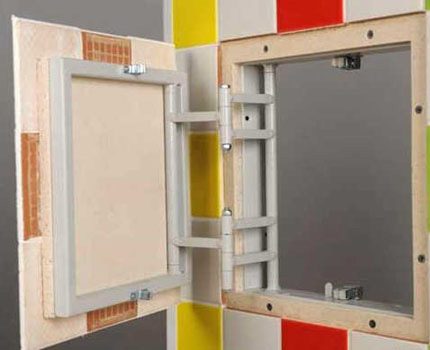
Option # 2 - Hinged Wall Design
The second type of boxes is with an opening external wall. Moreover, the wall can open completely or a certain part of it.
The structure of these structures is similar to the structure of the box with a solid wall, but differs by the presence of shelves inside - the free space near the pipes is often used as a cabinet.
Also, often with vertically arranged pipes, the external wall is assembled from different materials - for example, a plastic panel at the bottom, and plumbing blinds or a roller blind on top, behind which a cabinet with shelves is hidden.
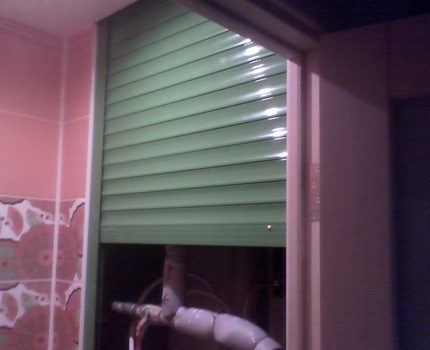
Owners prefer to build capital multi-level plasterboard boxes or put plastic panels in their toilet rooms. Moreover, the choice of colors of the latter is able to please with its variety and low cost.
The opening wall is an extremely successful solution, especially when not only pipes are located behind it, but also other communication elements - a boiler, water meters, etc.
Rolleta undoubtedly wins here, having the main advantage - they rise, revealing the entire inner space of the box. And if necessary, they can be completely dismantled in a couple of seconds.
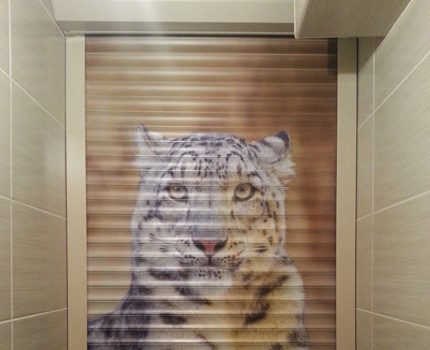
Stage # 2 - choose the shape and size of the structure
The shape and size of the future box, which will hide the pipes in the toilet, completely depends on the features of the pipeline. In each case there will be its own nuances.
So, if the room is undergoing full-scale repairs with pipe replacement with the involvement of the construction team, you should immediately discuss with them the question of constructing a duct, behind which the pipes will hide.
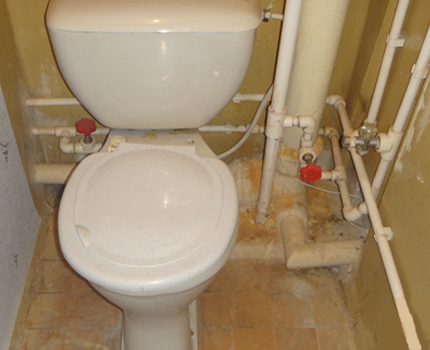
The same applies to the size of the box - the smaller the pipes, the easier it will be to mask.
The most basic condition is to maintain a distance of 3 cm from the extreme point of the most protruding pipe or water meter, if one is installed in the toilet room.
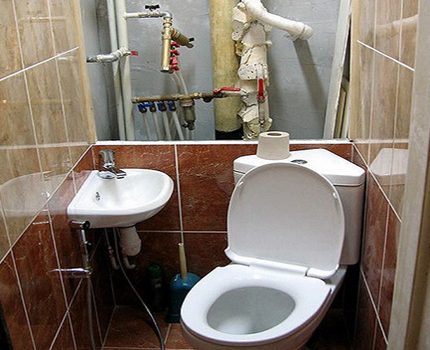
The location of the pipeline along one of the walls of the toilet is the most convenient option. If desired, all communications will be conveniently masked by placing a false wall made of drywall. And from above it will be possible to decorate with the same finishing material as the other walls in the room.
In addition to the false wall, the shape of the pipe masking box can be:
- rectangular or square length from top to bottom or from left to right;
- angular or complex in the form of a polygon in order to save the usable space of the toilet room;
- steppedwhen several boxes of various heights are installed in one room;
- round.
The most difficult thing is to implement a multi-level step design - you will first have to sketch on paper and calculate the length of each of the boxes.
Then calculate the amount of required materials and, having bought everything you need, proceed with installation work.
Stage # 3 - constructing a makeshift box
The design for masking the pipeline in the toilet room can be made on its own or invite masters.
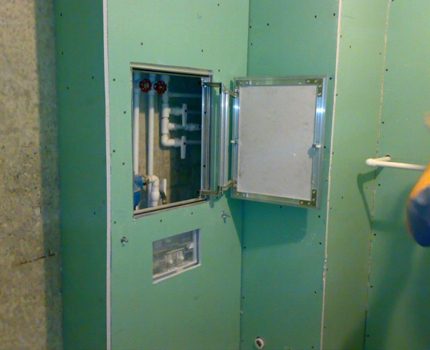
Among the materials used in the manufacture of boxes, most often the following:
- plastic panels;
- moisture resistant drywall;
- moisture resistant MDF panels or plywood;
- plumbing blinds, roller blinds, blinds.
If drywall requires additional finishing with tiles, wallpaper or other material, then all other options are used as a finish coating.
To install panels or blinds, you have to build a frame. To do this, use a metal profile or wooden block. Self-tapping screws, a building mesh and a putty for aligning joints are also useful.
Of the tools - level, tape measure, screwdriver, grinder, pencil
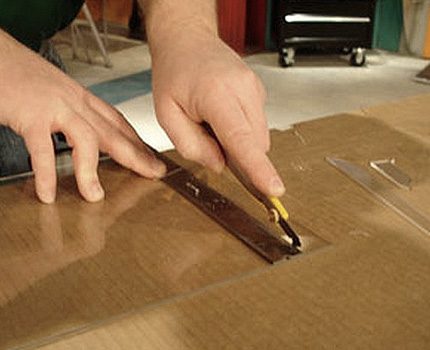
When the material is selected, you need to build a frame, securing metal profiles or wooden blocks with self-tapping screws.
On this basis, panels or sheets of drywall will be mounted.
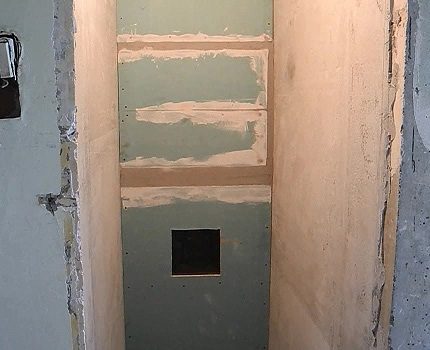
Each of the considered options for masking pipes is interesting in its own way. Which one to choose for your toilet room - depends on your needs and the location of the pipes.
As well as the availability of free time for the arrangement and the desire to do so. Indeed, to mask pipes in a small toilet, it will take significantly less time than in a combined type bathroom.
We also have instructions on how to make a box in the bathroom and a selection of the best ideas that will help you securely hide the pipes in the combined bathroom and toilet. And also useful recommendations on the arrangement of plumbing hatches, which will be needed when constructing the duct in the bathroom and toilet.
We recommend that you familiarize yourself with these materials:
- How to close the pipes in the toilet: how best to hide and hide the pipeline
- How to hide pipes in a bathroom: an overview of the best ways to mask a pipe
- We make a box for pipes in the bathroom: the choice of building material + installation instructions
- Revision plumbing hatches for the bathroom and toilet: types, placement rules, mounting features
Conclusions and useful video on the topic
You can hide numerous pipes in the toilet behind a plastic box.
The video demonstrates how to organize this correctly:
The pipeline masking box can be functional - it is enough to equip the space with shelves, which can comfortably fit useful household items. About this video clip:
When the features of the pipeline do not allow the full use of the cabinet for storing household trifles in the toilet, it can be improved. How to do this, the video prompts:
The box can be made of drywall. The stages of the work and decoration of the finished box are shown in the video clip:
Close the pipes will help plumbing blinds and roller blinds. More about this method in the video:
The choice of the best option for masking pipes in the toilet completely depends on the features of their location in this room. The more compact they are, the easier it will be to hide them.
If you wish, you can independently make a design from plastic panels or put plumbing fixtures - all this is easily mounted, and if necessary, it is no less easy to disassemble.
Did you make the original pipe box with your own hands? Tell us what material you used for this, how much time it took you and whether you are satisfied with the result. Write your comments in the block under this article, add a photo of your own made box - your example will inspire many home craftsmen!

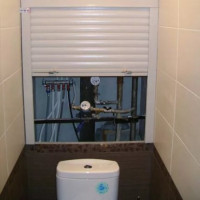 How to close the pipes in the toilet: how best to hide and hide the pipeline
How to close the pipes in the toilet: how best to hide and hide the pipeline 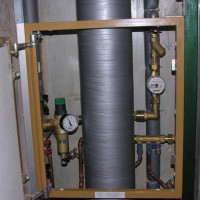 How to hide pipes in a bathroom: an overview of the best ways to mask a pipe
How to hide pipes in a bathroom: an overview of the best ways to mask a pipe 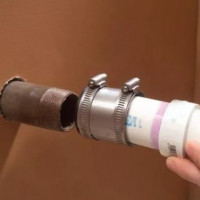 The connection of plastic pipes with metal: an analysis of the best methods and mounting nuances
The connection of plastic pipes with metal: an analysis of the best methods and mounting nuances 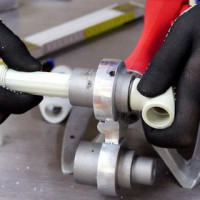 DIY welding technology for polypropylene pipes: an overview of methods and nuances
DIY welding technology for polypropylene pipes: an overview of methods and nuances 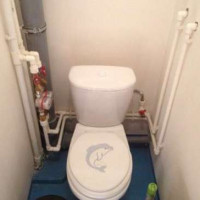 Replacing pipes in the toilet from A to Z: design, selection of building materials, installation work + error analysis
Replacing pipes in the toilet from A to Z: design, selection of building materials, installation work + error analysis 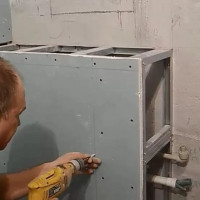 We make a box for pipes in the bathroom: step-by-step installation instructions
We make a box for pipes in the bathroom: step-by-step installation instructions  How much does it cost to connect gas to a private house: the price of organizing gas supply
How much does it cost to connect gas to a private house: the price of organizing gas supply  The best washing machines with dryer: model rating and customer tips
The best washing machines with dryer: model rating and customer tips  What is the color temperature of light and the nuances of choosing the temperature of the lamps to suit your needs
What is the color temperature of light and the nuances of choosing the temperature of the lamps to suit your needs  Replacement of a geyser in an apartment: replacement paperwork + basic norms and requirements
Replacement of a geyser in an apartment: replacement paperwork + basic norms and requirements
I did it very simply, but I was lucky: the pipes are located just behind the toilet, and the toilet is sheathed with plastic panels. I closed the pipes with panels by one third and above and below, and in the middle I made the doors of them. It turned out conveniently in the sense that there is easy access to taps and pipes themselves in case of minor accidents. And in more complex cases, the entire structure is easy to disassemble.
We decorated the pipes with a mirrored false wall. Of course, we stole the toilet area, but it’s not scary, because the back wall was still empty. A false wall was made with flaps like lockers. Below we have household chemicals, and the top opens to access the pipes in case of emergency. I read your options with pleasure.
Roman, hello. Tell me, how did you make a fake wall? are there any photos?
Hello. You can hide the pipes in the toilet or shower behind a false panel or duct. The principle of their manufacture is quite simple: a frame made of metal profiles and sheathing from plastic panels or drywall. Also, instead of metal profiles, you can use wooden battens. But profiles are faster and more practical. I enclose a photo of the implementation of such false panels. In drywall, it is not difficult to cut openings for shelves or technological hatches.
We have a combined bathroom and very little free space. I want to make it beautiful, but not take away the extra space. Probably a drywall box is my option. Or generally plastic, but I do not like them.